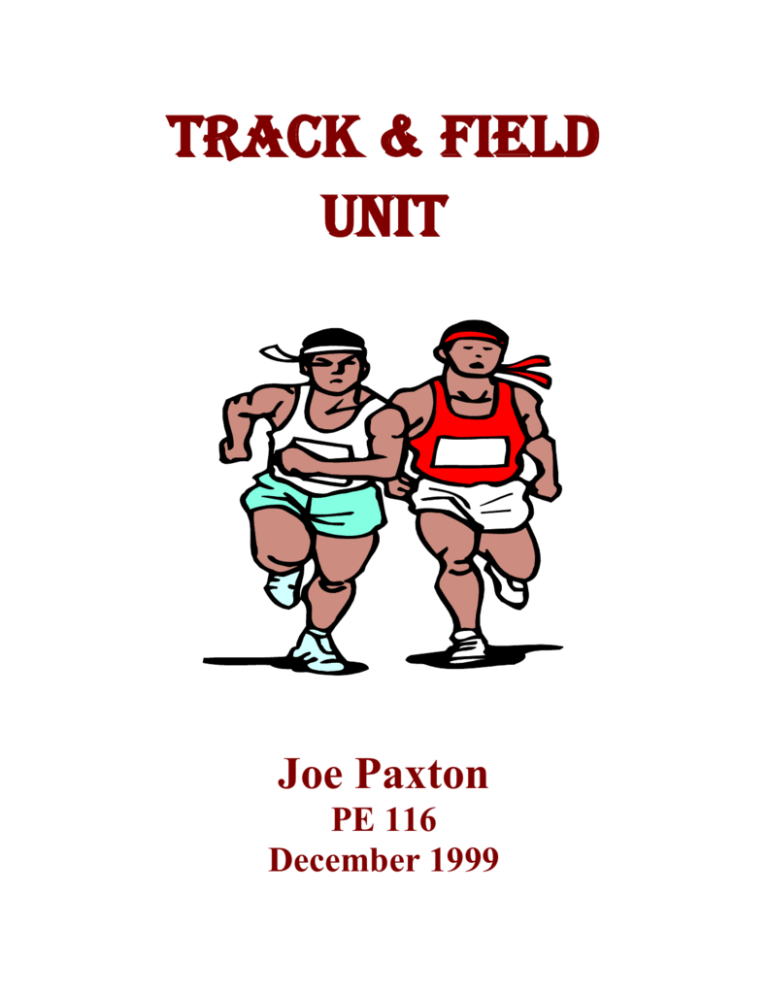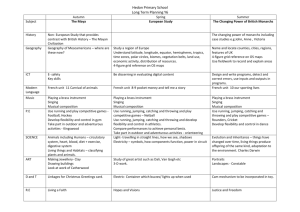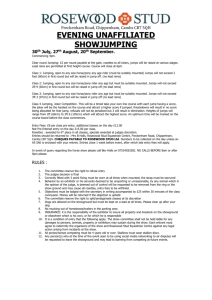Track & Field Unit - Paxton Enterprises
advertisement

Track & Field Unit Joe Paxton PE 116 December 1999 Table of Contents Content Page Number Track & Field Block Plan 3 - 5 Global Goals 6 Objectives Psychomotor 7 Cognitive 8 Affective 9 Physical Fitness 10 Special Considerations 11 Pre-Assessment 12 Skills to be taught 13 Skill Cues 14 Equipment 15 Safety 16 Facilities Needed 17 Media or other Materials 18 Grading System 19 Certificates 20 - 21 Lesson Plans 22 - 24 2 Track & Field Block Plan Page 1 Day 1 Day 3 I. Introduction to Track & Field II. Stretch/Warm-up III. Lesson Focus a. Pre-test of Track & Field b. Introduction to Track & Field Rules c. Quiz with a partner IV. Closure Questions/Reviews rules I. II. III. V. VI. Day 2 I. II. III. IV. V. Introduction: Distance Running Stretch/Warm-up Lesson Focus a. Review Sprinting b. Sprinting Contest c. Introduction of Distance Running d. Practice Distance Running Culminating Activity a. Distance Running Contest Closure a. Questions/Reviews Distance Day 4 Introduction: Sprinting Stretch/Warm-up Lesson Focus b. Review Track & Field Rules c. Safety d. Demonstrate Sprinting e. Practice Sprinting Culminating Activity a. Sprinting Contest Closure a. Questions/Review Sprinting I. II. III. IV. V. 3 Introduction: Relays Stretch/Warm-up Lesson Focus a. Review Sprinting and Distance Running b. Distance Running Contest c. Introduction of Relays d. Practice Handoffs Culminating Activity a. Relay Contest Closure a. Questions/Review Relays Track & Field Block Plan Page 2 Day 5 I. II. III. IV. V. Day 7 Introduction: Jumping Events Stretch/Warm-up Lesson Focus a. Review Relays b. Relay Contest c. Introduce Jumping Events d. Practice Jumping Events Culminating Activity a. Long & High Jump Contests Closure a. Questions/Review Jumping Events VI. VII. VIII. IX. X. Day 6 I. II. III. IV. V. Introduction: Track & Field Tournament Stretch/Warm-up Lesson Focus a. Review Rules b. Running Form c. Jumping Form d. Throwing Form Culminating Activity a. Track & Field Tournament Closure a. Questions/Reviews Tournament Day 8 Introduction: Throwing Events Stretch/Warm-up Lesson Focus f. Review Jumping Events g. Long & High Jump Contest h. Introduce Throwing Events i. Practice Throwing Events Culminating Activity a. Shot Put and Discus Contest Closure a. Questions/Review Throwing Events I. II. III. IV. V. 4 Introduction: Track & Field Tournament Stretch/Warm-up Lesson Focus a. Review Rules b. Running Form c. Jumping Form d. Throwing Form Culminating Activity a. Track & Field Tournament Closure a. Questions/Reviews Tournament Track & Field Block Plan Page 3 Day 9 I. II. III. IV. V. Day 11 Introduction: Skills Test Stretch/Warm-up Lesson Focus a. Explain/Demonstrate Skills Test Culminating Activity a. Practice for Skills Test i. 100m. Dash ii. 1600m. Run iii. 400m. Relay iv. Long Jump v. High Jump vi. Shot Put vii. Discus Closure a. Question/Review Skills Test I. II. III. IV. V. Day 10 VI. VII. VIII. IX. X. Introduction: Skills Test Stretch/Warm-up Lesson Focus a. Skills test while others practice Skills test with teacher a. 5 students per time b. Try to get through most of tests c. Others practice Closure a. Question/Review Skills Test b. Hand back rules test and go over it. Day 12 Introduction: Skills Test Stretch/Warm-up Lesson Focus a. Practice for Skills Test Culminating Activity a. Practice Skills i. 100m. Dash ii. 1600m. Run iii. 400m. Relay iv. Long Jump v. High Jump vi. Shot Put vii. Discus b. Rules Test Closure a. Question/Review Skills I. II. III. IV. V. 5 Introduction: Skills Test Stretch/Warm-up Lesson Focus a. Sprinting Skills Test b. 1 students at a time c. Record fastest time Culminating Activity a. Rewards for top runners b. Rewards for top jumpers c. Rewards for top throwers Closure a. Questions/Review Track & Field Unit Plan Global Goals 1. Students will demonstrate correct running, jumping, and throwing techniques by scoring a 75% or higher on a skills test at the end of the unit. 2. Students will demonstrate a knowledge of the rules and history of Track & Field by scoring 80% or above on a written rules exam 3. Students will be honest while self-assessing and assessing other students. This is done in a partner situation with shooting drills. 6 Objectives: Psychomotor Performance: 1. Students will demonstrate correct running technique by running sprints, distance running, and running relays. Evaluation will be partner assessment and time. 2. Students will demonstrate correct jumping technique by improving their long jump by 1 foot and increasing their high jump by 4 inches 3. Students will demonstrate correct throwing technique by throwing the shot put and discus. Evaluation will be partner assessment and distance measurement. 4. Students will increase their physical fitness and performance by doing the skill better at the end of the unit compared to the beginning of the unit. 5. Students will be able to correctly identify rules and strategy used in Track & Field by successfully completing the rules test. 7 Cognitive Performance: 1. Students will demonstrate knowledge of the rules by scoring 80% or above on the written exam. 2. Students will show an understanding of track and field techniques by participating in track and field activities. 3. Students will demonstrate general knowledge of a track and field event. This is assessed by teacher observation during events and by a written test at the end of the unit. 4. Students will demonstrate an understanding for the importance of technique in order to be successful in track and field. This is assessed by teacher observation during track and field events. 5. Students will learn and understand the history of track and field and the Olympics. This is assessed by the written exam at the end of the unit 8 Affective Performance: 1. Students will demonstrate good social skills by working within a group and with a partner. 2. Students will use good sportsmanship by participating in competitions and encourage their teammates and opponents to succeed. 3. Students will be honest while self-assessing and assessing other students. This is done in a partner situation. 4. Students will show a positive attitude while participating in all track and field training techniques sessions and event competitions. 5. Students will be motivated and ready for participation each day for the entire track and field unit plan. 9 Physical Fitness: 1. Students will be able to perform fitness activities continuously for 5 minutes, on a daily basis. 2. Students will practice locomotor skills on cue for 30 seconds each locomotor, for 2 minutes total 3. Students will be engaged in cardiovascular warm-up continuously for 3 minutes on a daily basis. 4. Students will participate in leader activities and stretching daily. 5. Students will use track and field skills such as running, jumping, and throwing with partners, in a group, or individually. 10 Unit: Track & Field Class: Coed Size: 20 Students Grade: 7th Grade Skill Level: Beginner to intermediate Special Considerations: Running: If student is having problems getting the running technique, have the student walk through the running technique slowly. Jumping: If student is having problems getting the jumping technique, have the student use stationary jumping drills to help the student with their jumping technique. Throwing: If student is having problems getting the throwing technique, have the student use a lighter weight to throw in order to use correct technique. 11 Pre-Assessment: Pre-test of Skills: Students will be tested on running, jumping, and throwing performance, as well as, the rules and history. Students will be with a partner and given a checklist to grade each other’s skill level. Teacher observation will also be used to assess skill level. 12 Skills to be taught: Rules History Sprinting Distance Running Relays Jumping Throwing 13 Skill Cues: Rules: False starts (must wait until “Go” signal), lane violations (must stay in own lane during sprints), foot faults (can’t cross line before jumping) History: Olympic History and event history Sprinting: Starting procedure. Explode from blocks. Pump arms, run on toes (not flat footed), don’t have any side to side movement, everything should be in a straight line, develop a breathing rhythm. Distance Running: Obtain a good pace, don’t start to fast, use good running techniques, develop a breathing rhythm, save energy for final sprint. Relays: Develop good baton passing technique by passing the baton from left hand to right hand while running. Jumping events: 1) High Jump: Use a curve approach, use correct technique by jumping off outside foot. Bend back, lift feet. 2) Long Jump: Count steps to take-off board. Get # of steps down. Explode off strongest leg. Jump at 45-degree angle, tuck and land. Throwing events: 1) Shot put: hold shot with finger tips, rest against neck. Explode with one hop toward the sector and extend arm in a 45 degree angle. 2) Discus: Grip discus with finger tips, spin by crossing right foot over left and extend the throw at a 45 degree angle. 14 Equipment Needed: 1 Track 1 High Jump apparatus 1 Long Jump Pit 1 Shot-put/Discus Sector 4 Stopwatches 6 Relay Batons 15 Safety 1. Students need to be aware of where other students are running and not to get in the path of the running students. 2. Students need to watch for students throwing the discus and the shot-put to avoid getting hit. Students MUST pay attention when walking on the sector to retrieve the shot or discuss to avoid getting hit. 3. Students throwing the shot and discus must be aware enough to not throw the shot or discus in the direction of other students in or out of the sector. 4. Students must keep their head up while running to avoid collisions. 5. Students must stretch appropriately to avoid injury. 16 Facilities Needed: For maximum participation, indoor or outdoor track with a long jump pit, high jump apparatus, and a shot-put/discus sector. TRACK: 17 Media or Other Materials: Posters with track dimensions, rules, events. Posters of Olympic track athletes, who are good role models. Example Posters: Track and Field Dimensions Track Athlete Track & Field Rules 1. -------------2. -------------3. -------------4. -------------5. -------------6. -------------7. -------------8. -------------9. -------------10. -------------- Jane Doe 18 Grading System All students are expected to attend and dress for class daily. Failure to do so will result in a conference between teacher, student, parent, and administration. Students will be graded on: 1. Partner Assessment checklist 2. Rules & History knowledge worksheet 3. Skills Test – Pre and Post 4. Final Exam over rules and skill technique Points will be distributed as follows: Skill Test 35 pts Final Exam 50 pts In-class assignments and partner activities 10 pts Out of class worksheets or assignments 19 5 pts 20




